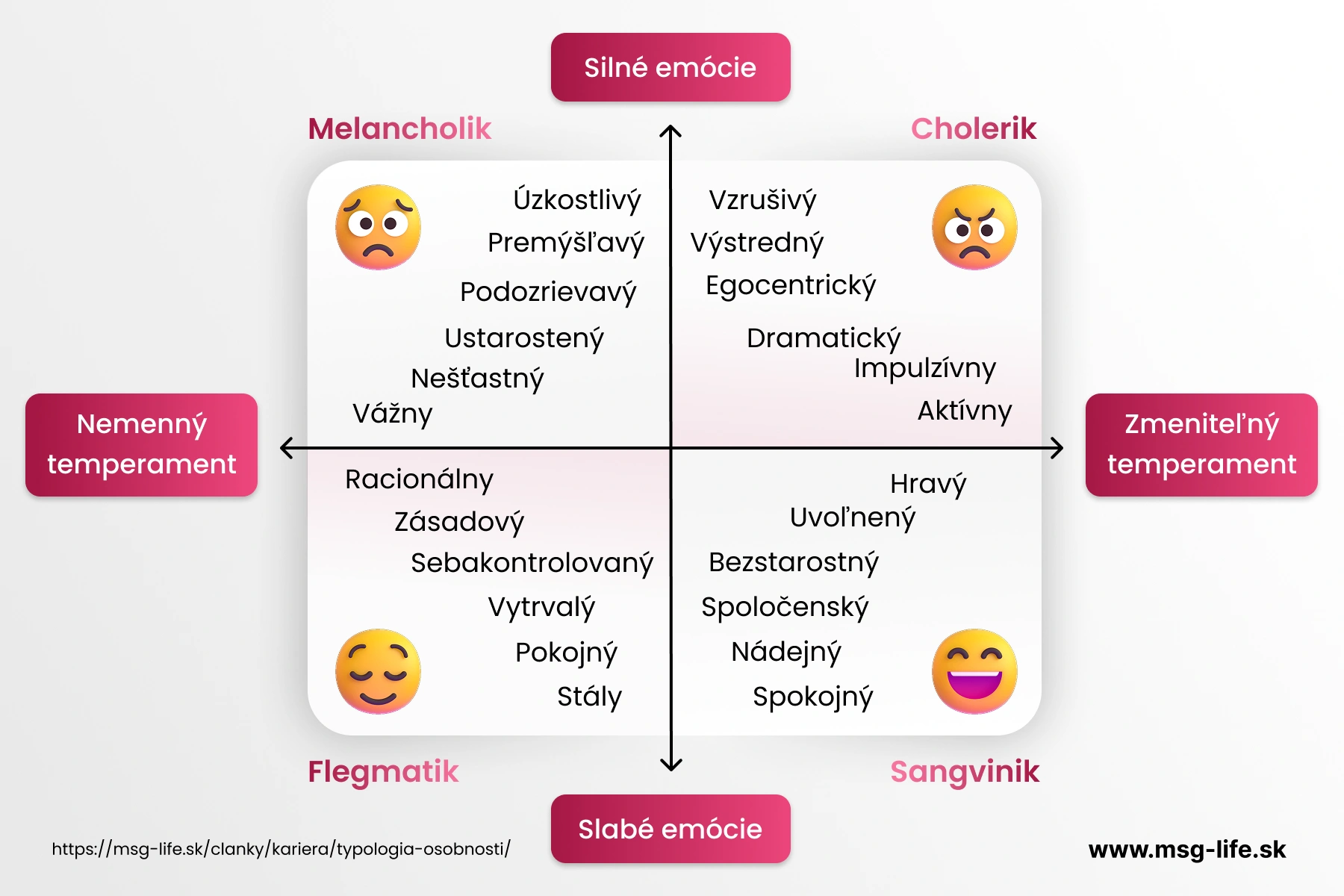Personality typology: all temperament tests in one article
Personality typology is a great tool to help you divide people into a few basic categories according to their traits and characteristics. This can be done based on a variety of theories, including Hippocratic, Goldberg, and Jungian. The advantage of personality typology is that it allows you to get to know your strengths and weaknesses and use them, for example, when looking for a new job.

In the article you will learn:
What is temperament?
Temperament is, from a psychological point of view, the totality of certain qualities by which a person is characterized. At the same time, it indicates how you view the world and what decisions you make.
Temperament has been of interest to many prominent personalities over the years. The first to address this topic was Hippocrates in the 4th to 5th centuries BC . His theory was later taken up by Galenos and then by Carl Gustav Jung, who brought his own view of temperament. Unlike Hippocrates, he divided people into two main groups – introverts and extroverts.
Regardless of the particular theory or personality, it is generally true that temperament is innate, manifested from childhood and does not change significantly throughout life. As a rule, only minor changes occur as a result of experience, new experiences, upbringing, education, and other external factors.
What are personality tests and why are they important?
Personality tests are a practical tool to get to know your personality as well as your strengths and weaknesses. You can then work with these to achieve better work results and improve your personal relationships.
Tests are also great in that they give you objective feedback based on your answers. They can also help you identify weaknesses or negative traits that you may not be aware of, but may be holding you back in many ways.
However, to get a relevant result, you need to fill in the temperament test truthfully. Therefore, always think carefully when answering the questions.
Basic stages of personality development
Each of us develops and grows throughout our lives. We go through several stages that influence us greatly and change our view of the world in certain ways.
The stages vary depending on what source you are getting your information from. For example, Erik Erikson talks about 8 stages:
- Trust vs. distrust (0 – 1 year)
- Independence vs. shame and doubt (2 – 3 years)
- Initiative vs. guilt (3 – 6 years)
- Diligence vs. inferiority (7 – 12 years)
- Ego-identity vs. role confusion (12 – 18 years)
- Intimacy vs. loneliness (20-25 years)
- Generativity vs. stagnation (30-65 years)
- Integrity vs. desperation (50+ years)
At each stage, different relationships influence a person. For example, in the first three it is relationships with parents and family, while in the sixth (intimacy vs. loneliness) it is friends and partners.
Sigmund Freud also spoke about the stages of personality development and divided them as follows:
- Oral stage (0 – 1 year)
- Anal stage (1-3 years)
- Phallic stage (3 – 6 years)
- Latent stage (6 – 12 years)
- Genital stage (12 years and older)
If you were to look at the stages of personality development from a biopsychosocial model, you might also encounter such a division:
- Prenatal period
- Newborn period (1 month)
- Infancy (up to 1 year)
- Toddler period (2 – 3 years)
- Preschool age (3 – 6 years)
- Younger school age (6 – 12 years)
- Adolescence (12 – 20 years)
- Early adulthood (20 – 40/45 years)
- Late adulthood (40/45 – 60 years)
- Old age (60 years and over)
4 types of temperaments according to Hippocrates and Galen
The importance of temperament was first explored by Hippocrates, who came up with the division into four personality types. He assigned to each the bodily juice that was supposed to have the greatest influence on it. However, to make using this theory easier, Galenos named all four personalities:
- Sanguines (blood) – are known for being sociable, energetic and communicative. This makes it easy for them to make friends, they have no problem working in a team, and they know how to inspire others. Their downside is that they are not always consistent, can be too impulsive and are easily distracted.
- Cholerics (bile) – they are ambitious, self-confident and dominant, which makes them perfect leaders. In addition, they know how to solve problems very well, they are direct and honest. Their weaknesses are impatience, explosiveness and difficulty accepting criticism.
- Phlegmatics (phlegm) – tend to be calm, reliable, patient, empathetic, loyal, loyal, organized, and emotionally stable. On the other hand, they can be lazy, reserved, introverted and lack initiative.
- Melancholics (black bile) – are thoughtful, sensitive, creative, artistic, loyal and have a sense of justice. Their weaknesses are emotional vulnerability, a tendency to pessimism, anxiety and melancholy.

Eysenck’s typology of personality traits
Hans Eysenck was also interested in personality traits and came up with the following division:
- Extraversion – introversion – while extraversion is known for sociability, impulsiveness and self-confidence, introversion is described by aloofness, quietness and a preference for solitude.
- Neuroticism – emotional stability – Eysenck argued that neurotic persons are prone to stress, emotionally unstable, and often experience anxiety and mood swings. Conversely, emotionally stable people are calm, balanced, and resilient to stress.
- Psychoticism – conformity – people with high psychoticism are impulsive, aggressive and egocentric. The exact opposite is low psychoticism, or conformity, characterized by sociability, sensitivity, and moral principles.
For a better understanding, Eysenck combined his theory with Hippocrates’:
- Extraversion + emotional stability = sanguine
- Extraversion + neuroticism = choleric
- Introversion + emotional stability = phlegmatic
- Introversion + neuroticism = melancholic
Pavlov’s typology
Ivan Pavlov created his own typology based on higher nerve activity. He divided the personalities in the same way as Hippocrates, taking into account the strength of the nervous processes, their equilibrium and ability to adapt.
- Sanguine – has a strong nervous system, quick reactions and can easily adapt to changes.
- Choleric – his nervous system is strong, but not balanced. That is why he is explosive and impatient.
- Phlegmatic – has a strong nervous system, is emotionally balanced and calm.
- Melancholic – unlike all three, he has a weak nervous system, which makes him unable to cope well with stress and prone to anxiety.
Big Five – The Big Five by Lewis Goldberg
Lewis Goldberg created one of the world’s most respected theories of personality. It is called the Big Five or OCEAN model and breaks down personality traits as follows:
- O – Openness – curiosity, originality, creativity and innovative thinking are prominent. Less pronounced is a preference for routine and conservatism.
- C – Conscientiousness – dominated by discipline, reliability, organization, precision and goal orientation. Minimal recklessness or impulsiveness appears.
- E – Extraversion (extraversion) – energetic, sociable, assertive and self-confident. Conversely, introversion and a preference for solitude rarely show up.
- A – Agreeableness – empathy, cooperation, trustfulness and willingness to help others prevail. Only occasionally is there mistrustfulness and stubbornness.
- N – Neuroticism – predominantly prone to stress, anxiety and instability. Calmness and emotional stability are less pronounced.
Personality typology according to Jung
The Swiss psychologist Carl Gustav Jung distinguished people according to two criteria:
- Attitude to the world – introversion (I) or extroversion (E)
- Psychological functions – thinking (T), feeling (F), perception (S) and intuition (N)

By combining these two factors, he created eight basic personality types:
- Extroverted Sensing (ES)
- Extroverted Intuition (EN)
- Extroverted Thinking (ET)
- Extroverted feeling (EF)
- Introverted Sensory (IS)
- Introverted Intuition (IN)
- Introverted Thinking (IT)
- Introverted Feeling (IF)
On the basis of all the information from Jung’s theory mentioned above, we can divide people further into so-called dichotomies :
- Extroversion vs. introversion
- Sensory vs. intuition
- Thinking vs. feeling
MBTI – 16 personality types according to Myers and Briggs

Jung’s temperaments, or personality types, were later expanded in the so-called MBTI (Myers-Briggs Type Indicator), as follows:
- Analysts:
- Architect (INTJ)
- Logician (INTP)
- Leader (ENTJ)
- Debater (ENTP)
- Diplomats:
- Defender (INFJ)
- Mediator (INFP)
- Protagonist (ENFJ)
- Agitator (ENFP)
- Guardians:
- Logistik (ISTJ)
- The Protector (ISFJ)
- Head (ESTJ)
- Consul (ESFJ)
- Explorers:
- Master (ISTP)
- Adventurer (ISFP)
- Entrepreneur (ESTP)
- Entertainer (ESFP)
16 personality types according to Socionics
Personality typology is also dealt with in the field of Socionics, created by Aušra Augustinavičiūtė. The division of personalities is very similar to Jung’s, as it is based on it.
Socionics speaks of 16 personalities, which are divided into four groups (blocks):
- Quadra:
- Don Quixote (innovator)
- Dumas (matchmaker)
- Robespierre (analyst)
- Hugo (enthusiast)
- Quadra:
- Zhukov (leader)
- Jesenin (romantic)
- Maxim (inspector)
- Hamlet (actor)
- Quadra:
- Balzac (critic)
- Napoleon (politician)
- London (entrepreneur)
- Dreiser (guard)
- Quadra:
- Gaben (master)
- Huxley (motivator)
- Stierlitz (director)
- Dostoevsky (humanist)
Personality types according to Holland
John Holland believed that every person belongs to one of six personality types. His model is called RIASEC and it looks like this:
- R (Realistic) – realistic – mechanical and practical type of person.
- I (Investigative) – researcher – an intellectual who can solve a variety of scientific problems.
- A (Artistic) – an artistic – creative person who is original and independent.
- S (Social) – social – a friendly person who is interested in social problems and likes to help others.
- E (Enterprising) – entrepreneurial – an ambitious and sociable person who is a born leader.
- C (Conventional) – conventional – organized person who likes order and structure.
Personality typology by color
The color personality typology uses four basic colors to define you as follows:
- Blue – objective people with minimal prejudice
- Green – peaceful and quiet person
- Yellow – well-adjusted, positive and lively person
- Red – courageous people who are not afraid of different challenges
Eight personality types were also created based on the colours:
- Red – Leader
- Red-yellow – motivator
- Yellow – inspirer
- Yellow-green – helper
- Green – supporter
- Blue-green – coordinator
- Blue – Observer
- Red-blue – reformer
Where can I find interesting personality tests?
You can find interesting personality typology tests on several websites. Popular ones include:
- Emiero.sk – the test will help you find out which job suits you best.
- Sociotype.com – find out what sociotype you are.
- 16personalities.com – based on Jung’s theory.
And as a bonus, check out high5test.com to find out what you’re good at.
Benefits of using personality typology in companies
When you know your strengths and weaknesses, you can work on them and improve them. This is a big plus not only for yourself, but also for the team you work within. By improving certain qualities, you will make it easier to work in the workplace and from your home office, and you will easily achieve both smaller and larger goals.
When a supervisor knows the personality traits of subordinates, it makes it easier for him to communicate with them and divide tasks. This minimizes conflicts and increases productivity.
Risks of using personality trait typology in companies
Although the typology of personality traits has many advantages, there are also disadvantages to be considered. These include, for example, stereotyping and pigeonholing of employees, bias in job and performance appraisals, discrimination against candidates, hindering career progression and underestimating skills.
The results of personality tests should be viewed with detachment. They can give you a lot of important information, but on the other hand, they are not always accurate and a person often has dozens of other valuable traits that the test does not reveal.
What temperaments do you have in your team?
Personality typology is a powerful and practical tool that you can use in all areas of your life, including work. If you want your team to be productive and perform at its best, use one of the theories to find out what makes your colleagues or subordinates tick. When you know their strengths and weaknesses, you’ll know what tasks they do best and how to communicate with them effectively.


